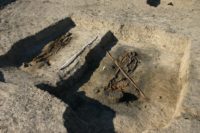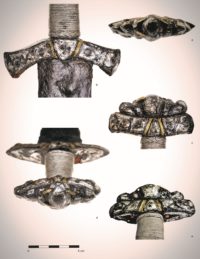Four richly-adorned graves found in a medieval cemetery in the village of Ciepłe, Eastern Pomerania, Poland, contained the remains of Scandinavian men, not the early Piast elite. The burials date to the time of the first king of Poland, Bolesław I the Brave (b. 967 – d. 1025) and were located in the center of the cemetery. They are the oldest of the 60-plus graves unearthed thus far and stand out for their high quality and their grave goods.
 The bodies were buried with extensive weaponry and horse fittings indicating the deceased were warriors. There were finely decorated swords, knives and spearheads, and complete sets of horse tackle (spurs, stirrups, bits, buckles). Other grave goods found in the graves include coins, combs, a set of scales with weights, metal and wood utensils.
The bodies were buried with extensive weaponry and horse fittings indicating the deceased were warriors. There were finely decorated swords, knives and spearheads, and complete sets of horse tackle (spurs, stirrups, bits, buckles). Other grave goods found in the graves include coins, combs, a set of scales with weights, metal and wood utensils.
The graves would have been special in their own right even if they had not been so full of funerary goods. They are chamber graves, which are very rare in the archaeological record of medieval Poland. Two of them were made of horizontal logs connected in the corners with cog joints, and the other two with vertical piles in the corner. The pile graves also featured huge coffins, the largest of their kind ever found in Poland. All four of the burials were oriented along the North-South axis, another unusual feature in Polish graves from this period. The group of burials was surrounded by a fence or palisade and was never interfered with, suggesting the locals remembered and respected the deceased.
 The cemetery was excavated between 2004 and 2014, and the four central burials generated much discussion between archaeologists and historians. There was debate over who the deceased had been, where they came from, whether they were Piast elite or possibly from Scandinavia or Western Europe where chamber graves from this period are well known. Now researchers have answered this question thanks to stable isotope and DNA analysis of bone samples from the remains. The four were indeed from Scandinavia, likely Denmark.
The cemetery was excavated between 2004 and 2014, and the four central burials generated much discussion between archaeologists and historians. There was debate over who the deceased had been, where they came from, whether they were Piast elite or possibly from Scandinavia or Western Europe where chamber graves from this period are well known. Now researchers have answered this question thanks to stable isotope and DNA analysis of bone samples from the remains. The four were indeed from Scandinavia, likely Denmark.
According to Dr. Wadyl, settlements in the area of Ciepłe were founded by Bolesław I the Brave. For the growing early Piast state, the settlement of people was one of the means to gain control and sovereignty over the eastern part of Pomerania and the extremely important and prospective Vistula route.
“The deceased buried in the central part of the cemetery represented the then social elites, as evidenced by the monumental structure of their graves and rich equipment. They probably belonged to a group of elite riders, but their role was probably not limited to the function of warriors,” Dr. Wadyl said.
Dr Wadyl believes that they collected taxes from the local population for the benefit of the Polish ruler. “This is indicated by scales with sets of weights found with two of the dead buried in chamber graves, and with the other two – touchstones used for assaying precious metal alloys, at the same time, indicating access to these metals and participation in trade,” he added.
We are a company of Discounts Code and opening a new site in our public. Your website presented us with valuable info to work on. You’ve done an inspiring method and our complete region will likely be thankful to you.
This discovery presents speculation about their demise. Were they all buried at that same time? Were the four men collecting taxes at the time of their deaths? Were they ambushed somehow? What was the consequence of their deaths? How was it possible the graves were so respected that the graves were not looted? Are there royal archives that might mention this event? Thank you for this post.
does anyone know the significance of the N/S position? Was that common for the pagans in this area? Just curious. Thanks in advance.
Really interesting. Lots more to be discovered about the link between Poland and Denmark. From the Smithsonian magazine last year:
A 10th-century grave in Denmark was long thought to contain the bones of a warrior believed to be a Viking woman. But a new analysis of the grave, located on the island of Langeland, suggests that the warrior wasn’t Viking, but rather Slavic, likely from the area of present-day Poland.
Scandinavian grave goods are not at all unheard of in the southern Baltic. But ..Did the gentlemen on the right really take ..a Scandinavian set of drainpipes with him to the afterlife?!?
According to Medieval chronicler Thietmar of Merseburg, Cnut the Great, who died in 1035 in Dorset, had been the son of a Polish princess who was the daughter of Mieszko I of Poland and sister of Bolesław I, Gunhilda, a.k.a. Sigrid Storråda or Świętosława.
Thietmar, who died in 1018, wrote: “..id est filiis Suenni persecutoris, pauca edissero. Hos peperit ei Miseconis filia ducis , soror Bolizlavi successoris eius et nati; quae a viro suimet diu depulsa non minimam cum caeteris perpessa est controversiam…”
The assertion that Harald’s and Canute’s mother was Boleslaw’s sister may explain some mysterious statements which appear in medieval chronicles, such as the involvement of Polish troops in invasions of England (cf. Thorkell the Tall).
According to others, however, Sigrid Storråda was the daughter of Skoglar Toste, so maybe Sigrid and Świętosława were two different acquaintances of Cnut’s dad.
I didn’t think the old adage death and taxes went that far back, but I stand corrected.